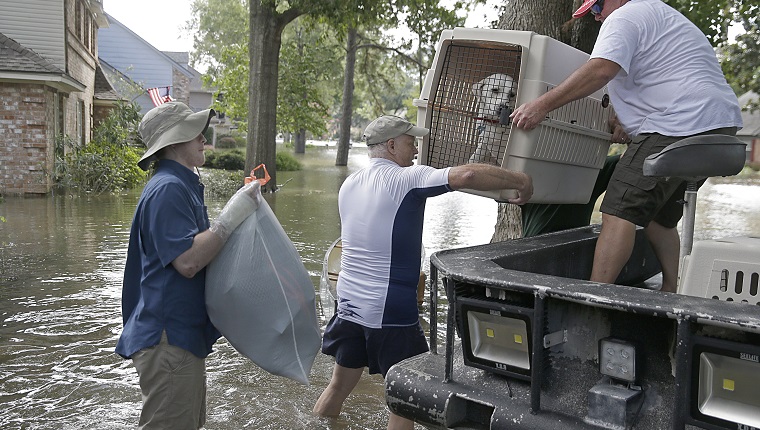Hurricane season in the United States usually lasts from June to November, and it’s especially important during this time to prepared for an emergency and possible evacuation with a plan that includes your pets.
If you live in an area where hurricanes are known to hit land or you’re currently in the path of a hurricane, you must take precautions to keep yourself, your family, and your dogs safe. It’s never too early to start preparing, so if you don’t have an emergency plan yet, now is a good time to make one.
Even if you end up not needing to evacuate, it’s better to have a plan and not need it than to need a plan and not have one. Here are a few tips for preparing for a hurricane and evacuating with your dogs.
Stay Informed, Alert, & Ready

In any natural disaster, it’s very important that you stay up-to-date on the situation and know when to evacuate, if necessary. There are several ways to go about getting notifications when a hurricane is on the way.
It’s best to have more than one means of staying informed in case one method fails. Having information before and during a disaster will help you make decisions about how to keep yourself and your dogs safe.
Here are a few ways to stay updated during a hurricane:
- Know the risks for where you live. The National Oceanic and Atmospheric Administration (NOAA) put together a map showing where storm surges associated with hurricanes are most likely to affect people in the United States. If you live in one of the at-risk areas, you should take extra precautions and definitely have an evacuation plan. You should also keep your eye on the local news so you’re aware of any storms that might be coming and any evacuations that might be necessary.
- Have your phone charged and ready. In today’s age, your phone might be the best device you have for staying informed, communicating, and finding out where you need to go in a disaster. It’s always a good idea to have a charger where you can easily grab it and go. You should also consider buying an external battery in case the power goes out, so you can charge your phone on the go, or if you need some extended battery life.
- Download the FEMA mobile app. This app sends you notifications about natural disasters from the National Weather Service, gives you preparedness tips, and helps locate shelters among other things. Some reviewers say the app sends too many notifications, but it’s better to be too informed than not informed at all.
- You should have a solar-powered or crank radio, just in case your phone dies or you lose it. Set the frequency to a NOAA Weather Radio All Hazards (NWR) station. It will help you stay informed, and these stations broadcast 24/7.
Make Preparations For Your Dogs
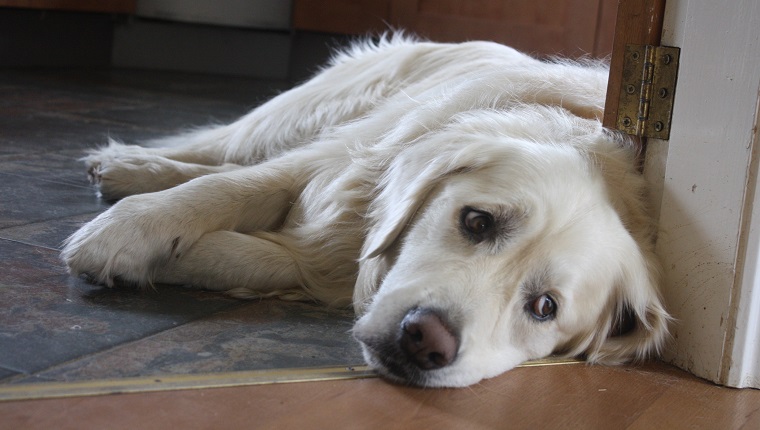
Your dogs can’t prepare themselves for a hurricane, so it’s up to you to make sure they’re safe and ready when the storm hits. Preparation goes beyond making sure your dogs aren’t tied up or chained outside during a storm (they shouldn’t be chained up outside without supervision, anyway).
You must prepare your home for your dogs and make sure that you’re ready to go if an evacuation becomes necessary.
Here are some tips for making preparations for your dogs to get through a hurricane:
- Keep your dogs inside before and during the storm. Arrange a place for them to go potty indoors if necessary. You can get puppy pads, faux grass, and cleaning supplies to take care of the mess. If it’s too dangerous for you to be outside, it’s too dangerous for your dogs.
- Update your dogs’ microchips and identification. Make sure they have your current information and an emergency contact phone number. If you lose your dogs, this gives you a much better chance of finding them.
- Get an emergency alert sticker for your front door. Many fire departments offer these stickers. The sticker allows you to list the number of pets that live in your home. If you’re forced to leave your dogs behind for any reason, the sticker will let rescue workers know how many pets to look for.
- Exchange contact information with your neighbor. If you’re not home during an evacuation, make sure you have a neighbor or friend close to where you live who can take your dogs temporarily until you can meet up with them. Discuss this with them before an emergency occurs, and have a few backup neighbors in case they’re not home. You should save their information in your phone, but also have a physical card with their information if your phone dies or you lose it.
- Return the favor. If you’re able to take your neighbor’s pets in a disaster, let them know they can rely on you, too.
- If you’re taking shelter at home, make sure you have enough food and water for two weeks for each animal, as well as any regular medication they’re taking. Those who feed their dogs raw food or any food that requires refrigeration or cooking should be aware that the power may go out for several days, and that food could spoil. Have non-perishable canned food or dry kibble in your emergency supplies. Replace the water in your emergency supplies every two months if you don’t use it. Keep all of these supplies out of any parts of your home that may be subject to flooding.
Plan Where To Go In An Evacuation
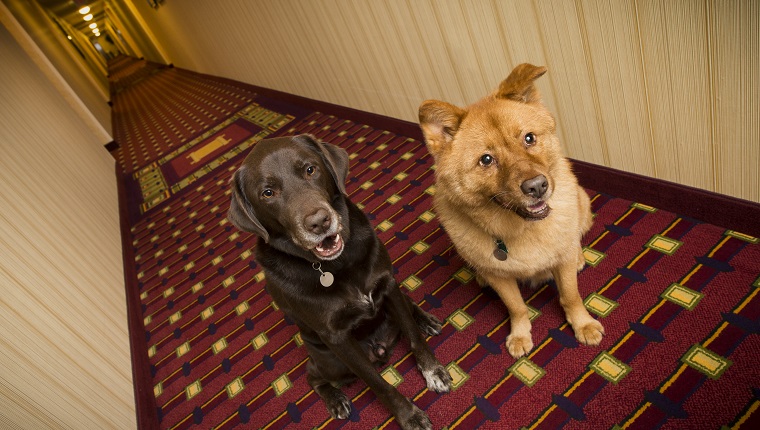
If you must evacuate, you’ll need to have a safe place to go with your family that will also take in your dogs. Your whole family should be aware of where you will go in case you get separated.
Several options might be available, but some might be ruled out if they’re also in an area that must be evacuated or if they don’t accept pets. Many evacuation shelters prohibit animals due to health and safety regulations, so check ahead of time. Do not rely on shelters unless they specifically tell you that animals are allowed.
Have a backup emergency meetup location if your first option isn’t available.
Here are a few places that might be safe for you and your dogs to go if you must evacuate:
- A friend or family member who lives in a safe location is likely to be the best option. Make arrangements with them ahead of time, and make sure that they have room for your dogs if you need to stay there for a while. Choose a few different friends or family members in case one isn’t able to take you in.
- Return the favor. If you’re able to take in dogs during a hurricane or other natural disaster, let friends and family know. Reach out on social media and tell people that you have room. It takes teamwork to keep our dogs safe.
- Find hotels and motels that will allow dogs. Some may be fully booked due to the evacuation, so make sure you have several options. Two websites that let you search specifically for lodgings that allow pets are bringfido.com and expedia.com.
- If you and your family must go to a shelter or location where pets are not allowed, search the area for pet sitters, kennels, vet’s offices, or animal shelters, as sometimes these places make special arrangements for pets in cases of emergencies and natural disasters. Call ahead to make sure they have room.
Pack Your Emergency Kit
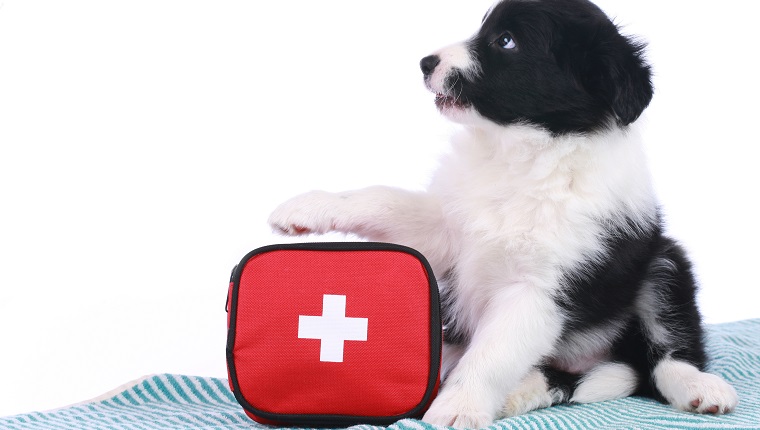
Whether you’re taking shelter at home or need to evacuate, an emergency kit will help you provide for your dogs during a hurricane. This kit should be fairly easy to pack up and go in a hurry if need be. Keep it somewhere that is not subject to flooding.
It will have items specifically for your dogs, so you’ll need to pack a separate kit for you and the humans in your family. You’ll need supplies for several days.
Here are a few things you should pack in your emergency kit for your dogs:
- A first-aid kit for canines. Your veterinarian will be able to provide you with some advice for your dog’s first-aid needs, but you can also click here for some info on what to include in a first-aid kit for pets. Familiarize yourself with pet first aid in case you need to use it.
- The ASPCA recommends packing three to seven days worth of food for each dog.
- Medical records for each dog. Some locations require proof of vaccination before they will allow your dogs to stay. You should keep these on a USB drive for easy storage. Make sure you have recent photos of your dogs, too.
- One to two week’s worth of any of your dogs’ regular medication.
- Cleaning supplies. Paper towels, bags, and anything else you might need.
- Disinfectant or dish soap.
- Seven days worth of water for each dog. Replace every two months if it goes unused.
- A crate, kennel, or carrier for each dog. Bring bedding for them, as well.
- Extra supplies. Leashes, harnesses, toys, collars, food and water bowls, etc. If you have any of your dogs’ old items that you’ve replaced, you can keep the old items in your emergency kit, rather than buying new stuff just for this purpose.
Evacuating With Your Dogs
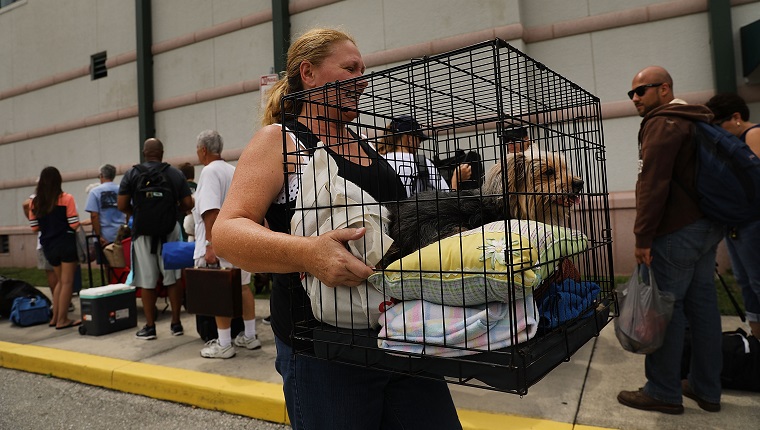
If you receive word that you must evacuate, do not wait, even if you don’t see signs of danger right away. Take your dogs and your emergency kit.
In natural disasters, some people are forced to go right away and leave pets behind, so don’t wait until the last minute to get going. Listen to emergency workers and get your family and dogs to safety.
Here are a few tips if you must evacuate with your dogs due to a hurricane:
- If you’re forced to evacuate in a hurry, leave all non-essential possessions behind. Nothing is worth risking your life or the lives of your dogs.
- Keep your dogs on leashes or in carriers at all times. When frightened, dogs often bolt or hide. This will be a scary, stressful situation for them, and you may not have time to chase them down or look for them.
- Try to keep your dogs’ feeding and medication schedules as consistent as possible.
- Stay calm and don’t take risks. Your family should know what to do and where to go. You should also designate a caretaker for your dogs at all times. Don’t assume someone is watching them. Take shifts if you have to, but make sure someone always supervises and cares for them.
- Keep up with the news and emergency notifications. Do not return home until emergency services inform you that it’s safe to do so.
What other tips do you have for keeping your dogs safe during a hurricane? What should people bring for their dogs if they must evacuate? Let us know in the comments below.
Related Articles:
Click the bold links in the article to shop for your dog and support our content!
